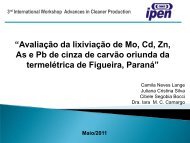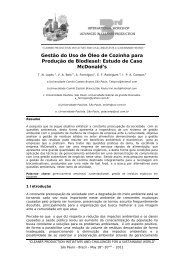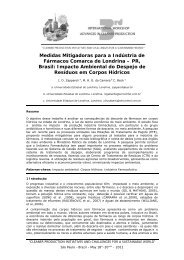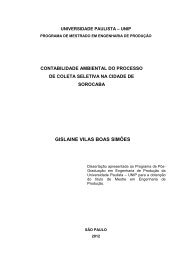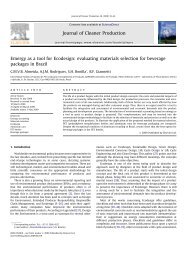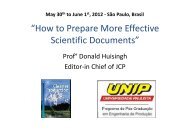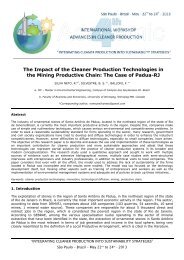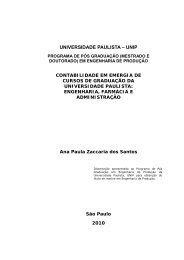Desenho da Metodologia da Avaliação do Ciclo de Vida (ACV) do ...
Desenho da Metodologia da Avaliação do Ciclo de Vida (ACV) do ...
Desenho da Metodologia da Avaliação do Ciclo de Vida (ACV) do ...
Create successful ePaper yourself
Turn your PDF publications into a flip-book with our unique Google optimized e-Paper software.
83 rd International Workshop | Advances in Cleaner Productionequivalent/ kg emission);• acidificação: Acidification - only characterization factors including fate wereused for the CML baseline method. The method was exten<strong>de</strong>d with Nitric oxi<strong>de</strong>,air (is nitrogen monoxi<strong>de</strong>). Acidification: Corrected the characterisation factorfor Sulphur dioxi<strong>de</strong> from 1 to 1,2 SO2 eq . This factor of 1,2 SO2 eq for SO2 isincluding fate;• eutrofização: Euthrophication - nitrogen compounds completed. Nitrogen isreplaced by Nitrogen, total, with same characterisation factor;• ecotoxi<strong>da</strong><strong>de</strong> <strong>de</strong> águas <strong>do</strong>ces: Fresh water aquatic ecotox - Marine aquaticecotoxicity, Terrestrial ecotoxicity: Characterisation factors Naphthalene andNaphthalene (subcompartment Ocean) corrected;• toxici<strong>da</strong><strong>de</strong> humana: Human toxicity - Characterisation factors, expressed asHuman Toxicity Potentials (HTP), are calculated with USES-LCA, <strong>de</strong>scribing fate,exposure and effects of toxic substances for an infinite time horizon. For eachtoxic substance HTP's are expressed as 1,4-dichlorobenzene equivalents/ kgemission. Chromium (soil) -> Chromium (VI) (soil, agricultural).O software a ser utiliza<strong>do</strong> é o SimaPro 7, <strong>de</strong>senvolvi<strong>do</strong> pela empresa PréConsultants, e que trata-se <strong>de</strong> uma ferramenta profissional para coletar, analisar emonitorar o <strong>de</strong>sempenho ambiental <strong>de</strong> produtos, processos e serviços. Ele permitemo<strong>de</strong>lar e analisar <strong>do</strong>s mais complexos aos mais simples ciclos <strong>de</strong> vi<strong>da</strong> <strong>de</strong> umaforma sistemática e transparente, seguin<strong>do</strong> as recomen<strong>da</strong>ções <strong>da</strong> série ISO 14040.A informação no SimaPro encontra-se organiza<strong>da</strong> em projetos, os quais po<strong>de</strong>mincluir diversos ciclos <strong>de</strong> vi<strong>da</strong> <strong>de</strong> um ou vários produtos e cujos processos po<strong>de</strong>mser extraí<strong>do</strong>s <strong>da</strong>s bases <strong>de</strong> <strong>da</strong><strong>do</strong>s <strong>do</strong> SimaPro. Uma vez <strong>de</strong>fini<strong>do</strong> o <strong>Ciclo</strong> <strong>de</strong> Vi<strong>da</strong>, oSimaPro calcula a soma <strong>da</strong>s diversas intervenções ambientais associa<strong>da</strong>s à uni<strong>da</strong><strong>de</strong>funcional <strong>de</strong>fini<strong>da</strong> na mo<strong>de</strong>lação.Para verificar a quali<strong>da</strong><strong>de</strong> <strong>do</strong>s <strong>da</strong><strong>do</strong>s será utiliza<strong>da</strong>a matriz pedigree. A Análise <strong>do</strong> Inventário <strong>do</strong> <strong>Ciclo</strong> <strong>de</strong> Vi<strong>da</strong> envolve a coleta <strong>de</strong><strong>da</strong><strong>do</strong>s e procedimentos <strong>de</strong> cálculo para quantificar as entra<strong>da</strong>s e saí<strong>da</strong>s <strong>de</strong> umsistema <strong>de</strong> produto. Itens a serem consi<strong>de</strong>ra<strong>do</strong>s:• Fases: coleta <strong>de</strong> <strong>da</strong><strong>do</strong>s; vali<strong>da</strong>ção <strong>do</strong>s <strong>da</strong><strong>do</strong>s; relacionar <strong>da</strong><strong>do</strong>s a uni<strong>da</strong><strong>de</strong> <strong>de</strong>processo (alocação inclui reuso e reciclagem); relacionar <strong>da</strong><strong>do</strong>s a uni<strong>da</strong><strong>de</strong>funcional; agregação <strong>do</strong>s <strong>da</strong><strong>do</strong>s; refinamento <strong>da</strong>s fronteiras <strong>do</strong> sistema;• Recomen<strong>da</strong>ções <strong>da</strong> ISO 14040: <strong>de</strong>senho <strong>de</strong> fluxogramas <strong>de</strong> processo que<strong>de</strong>lineiam to<strong>da</strong>s as uni<strong>da</strong><strong>de</strong>s <strong>de</strong> processo; <strong>de</strong>scrição <strong>da</strong>s uni<strong>da</strong><strong>de</strong>s <strong>de</strong> processoscom os <strong>da</strong><strong>do</strong>s categoriza<strong>do</strong>s; <strong>de</strong>scrição <strong>da</strong> técnica <strong>de</strong> coleta <strong>de</strong> <strong>da</strong><strong>do</strong>s e cálculo;fornecimento <strong>de</strong> instruções para <strong>do</strong>cumentação <strong>de</strong> casos especiais,irregulari<strong>da</strong><strong>de</strong> ou outros;• Evitar a duplicação ou falhas <strong>de</strong> contagem: <strong>de</strong>screver ca<strong>da</strong> processo;<strong>do</strong>cumentar os procedimentos <strong>de</strong> alocação; referenciar as fontes <strong>de</strong> <strong>da</strong><strong>do</strong>s;incluir informações sobre a quali<strong>da</strong><strong>de</strong> <strong>do</strong>s <strong>da</strong><strong>do</strong>s;• Vali<strong>da</strong>ção <strong>do</strong>s <strong>da</strong><strong>do</strong>s: balanço <strong>de</strong> massa; balanço <strong>de</strong> energia; análisecomparativa <strong>de</strong> fatores <strong>de</strong> emissão;• Procedimentos a a<strong>do</strong>tar no caso <strong>de</strong> ausência <strong>de</strong> <strong>da</strong><strong>do</strong>s: incluir um valordiferente <strong>de</strong> zero, com justificativa; incluir um valor igual a zero, comjustificativa; incluir um valor calcula<strong>do</strong> com bases em tecnologias similares;<strong>do</strong>cumentar <strong>da</strong><strong>do</strong>s ausentes;• Relacionar <strong>da</strong><strong>do</strong>s a uni<strong>da</strong><strong>de</strong>s <strong>de</strong> processo: dividir as entra<strong>da</strong>s e saí<strong>da</strong>sproporcionalmente;• Relacionar <strong>da</strong><strong>do</strong>s a uni<strong>da</strong><strong>de</strong> funcional: normalizar o fluxo <strong>de</strong> to<strong>do</strong>s osprocessos para uni<strong>da</strong><strong>de</strong> funcional;• Agregação <strong>de</strong> <strong>da</strong><strong>do</strong>s – recomen<strong>da</strong>ções: que o nível <strong>de</strong> agregação sejasuficiente para satisfazer o objetivo <strong>do</strong> estu<strong>do</strong>; que somente sejam agrega<strong>da</strong>ssubstâncias equivalentes e que tenham impactos ambientais similares; casonecessário agregar outros <strong>da</strong><strong>do</strong>s, incluir a justificativa na <strong>de</strong>finição <strong>do</strong> objetivo e<strong>do</strong> escopo ou na avaliação <strong>de</strong> impacto;• Uso <strong>da</strong> análise <strong>de</strong> sensibili<strong>da</strong><strong>de</strong>: excluir ou incluir etapas <strong>do</strong> ciclo <strong>de</strong> vi<strong>da</strong>“CLEANER PRODUCTION INITIATIVES AND CHALLENGES FOR A SUSTAINABLE WORLD”São Paulo – Brazil – May 18 th -20 th - 2011




